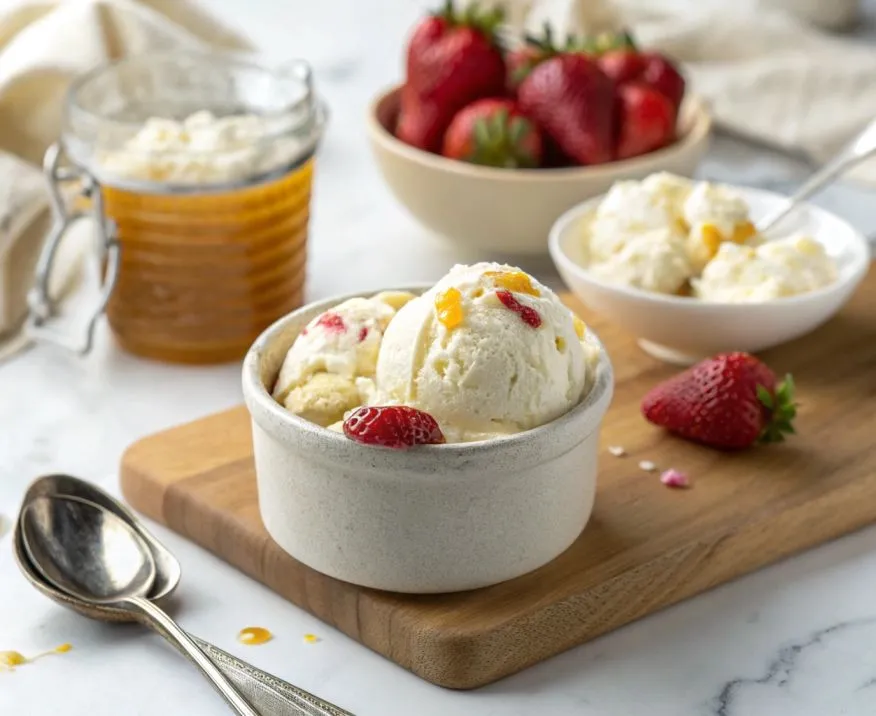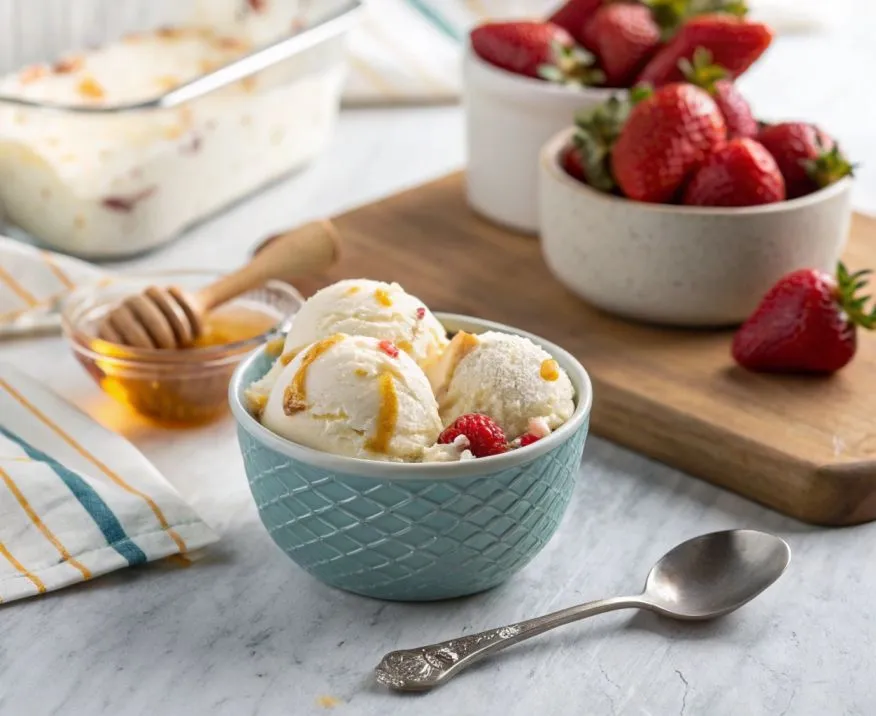Cottage Cheese Ice Cream – Unbelievably Good For You!
A Guilt-Free Indulgence That Feels Too Good to Be True
You love ice cream. Who doesn’t? That creamy, dreamy spoonful after dinner or on a hot afternoon feels like instant happiness. But here’s the catch—you’ve probably also felt the sugar crash, the bloating, or even a pang of guilt that sneaks in afterward.
Now imagine this: you’re enjoying all the richness of your favorite frozen dessert without the sugar overload, the bloating, or the guilt. That’s exactly what cottage cheese ice cream offers. This surprisingly smooth, protein-packed dessert has been making waves—and for good reason.
You’re not giving up flavor. You’re just choosing a smarter way to satisfy your sweet tooth.
Table of Contents
What Exactly Is Cottage Cheese Ice Cream?
If you’re picturing a bowl of icy, curdled cheese, don’t worry—you’re way off. Cottage cheese ice cream starts with smooth-blended cottage cheese (yes, the kind you’d normally eat with fruit or crackers). It transforms into a luxuriously creamy base that mimics traditional ice cream—only it’s packed with protein, nutrients, and way less sugar.
You might’ve seen it trending on TikTok or flooding Pinterest boards. Health-conscious foodies, fitness buffs, and curious snackers alike are embracing this clever creation because it offers all the indulgence of ice cream with a clean, nutrient-rich profile.
Why It’s Becoming a Favorite in Healthy Kitchens
- It’s blender-friendly—no fancy ice cream maker needed
- It works with almost any flavor combo you like
- It helps you stay on track with your health goals while still delivering great flavor.
- And yes—it actually tastes good
You’re getting more than just dessert—you’re nourishing your body while enjoying every bite.
The Health Perks of Cottage Cheese Ice Cream
If you’re wondering whether this is just another trendy health hack or the real deal, let’s break down the actual benefits. Spoiler alert: it’s both trendy and beneficial.
1. Sky-High Protein Content
Your body needs protein to build muscle, repair cells, and keep you full between meals. And you know what? One cup of full-fat cottage cheese offers around 25 grams of protein. That’s more than most protein bars.
By turning that base into a frozen treat, you’re essentially upgrading your dessert into a functional snack that fuels your body.
2. Naturally Lower in Sugar
Unlike store-bought ice creams that are loaded with corn syrup, stabilizers, and mystery ingredients, your homemade version can rely on:
- Honey
- Maple syrup
- Fresh fruits
- Even stevia or monk fruit (for sugar-free options)
You’re in full control of the sweetness, which makes this a win for anyone watching their sugar intake or avoiding blood sugar spikes.
3. A Friendlier Option for Your Gut
While not everyone handles dairy the same way, many people find that cottage cheese is easier to digest than milk-based ice cream. And if you choose probiotic-rich or lactose-free cottage cheese, you’re doing your gut even more favors.
How You Can Make Cottage Cheese Ice Cream at Home

You don’t need any fancy tools—just a blender, a spoon, and a little bit of patience while it chills. Here’s how you can turn this magical mix into your go-to dessert.
Basic Ingredients
| Ingredient | Quantity |
|---|---|
| Full-fat cottage cheese | 1½ cups |
| Honey or maple syrup | 2–3 tbsp |
| Vanilla extract | 1 tsp |
| Add-ins (berries, nuts) | Optional |
Flavor Add-In Ideas
- Berries for natural sweetness
- Peanut or almond butter for richness
- Dark chocolate chips for indulgence
- Chia seeds or flaxseed for added fiber
- Cinnamon or cocoa powder for a twist
Step-by-Step Instructions
- Scoop your cottage cheese into a blender and blend until completely smooth.
- Add in your chosen sweetener and vanilla extract.
- Stir in your favorite flavor additions.
- Pour the mixture into a shallow dish or loaf pan.
- Freeze for about 2–3 hours or until firm.
- Let it sit at room temperature for 5–10 minutes before scooping.
Voilà. You’ve just made a creamy, dreamy dessert you can enjoy without any guilt.
Popular Flavor Variations to Try
Here’s the fun part. You can make this recipe your own—mix, match, and experiment.
Strawberry Cheesecake Ice Cream
- Blend in fresh strawberries and a tablespoon of softened cream cheese.
- Swirl in some crushed graham crackers just before freezing.
Chocolate Peanut Butter
- Add 1 tbsp cocoa powder and 2 tbsp peanut butter.
- Stir in dark chocolate chunks for a “Reese’s in a bowl” experience.
Tropical Mango Coconut
- Blend in diced mango and top with unsweetened coconut flakes.
- A splash of lime juice adds brightness.
Each of these versions is nutrient-dense, delicious, and utterly satisfying.
How It Stacks Up Against Regular Ice Cream
You might still be wondering how this creamy cottage treat compares to your store-bought pint. Let’s look at the facts:
| Nutrient | Cottage Cheese Ice Cream | Regular Ice Cream |
|---|---|---|
| Protein per serving | 12–20g | 2–4g |
| Calories (average) | 150–250 | 200–350 |
| Added sugars | Low or none (customizable) | High (12–25g per serving) |
| Probiotic potential | Yes (depending on brand) | No |
| Satisfaction factor | High (due to protein/fats) | Short-lived sugar spike |
By making the switch, you’re not just cutting calories—you’re fueling your body in a smarter way.
Is It Right for You? Here’s Who Will Love It

You don’t need to be a health nut to appreciate the benefits. Cottage cheese ice cream fits beautifully into a variety of lifestyles:
- Trying to lose weight? This keeps you full longer.
- Following a low-carb or keto plan? Use low-sugar add-ins.
- Working on muscle gain? It’s a high-protein snack.
- Feeding kids? It’s a nutritious treat they’ll never suspect is healthy.
- Managing diabetes or insulin resistance? You can control the sugar.
If any of that sounds like you, this is one recipe worth adding to your weekly rotation.
Tips for Making It Perfect Every Time
- Go full-fat. Low-fat versions won’t give you that creamy texture.
- Blend it thoroughly. Don’t stop until it’s silky smooth.
- Taste before freezing. You can adjust sweetness as needed.
- Shallow pans work best. They help the mix freeze evenly.
- Don’t rush the thaw. Letting it sit for 5 minutes makes scooping easier.
You’re not just throwing ingredients together—you’re crafting your own frozen masterpiece.
Frequently Asked Questions (FAQ)
Does cottage cheese ice cream taste like cheese?
Not really. Once blended and flavored, the tanginess disappears. You’ll notice a rich, creamy texture, but no strong cheesy flavor.
Can you make it dairy-free?
While traditional cottage cheese is dairy-based, you can experiment with plant-based cottage cheese substitutes—though texture may vary.
Is it OK to eat every day?
Absolutely. It’s packed with protein and nutrients. Just keep an eye on your add-ins and portion sizes.
How long does it keep in the freezer?
You’ll get the best texture within 7–10 days. After that, it may become icy unless stored airtight.
Can you make it without added sweeteners?
Yes! Use ripe bananas, dates, or just fruit add-ins to keep things naturally sweet.
Conclusion: The Dessert You Deserve—Without the Downsides
You don’t need to swear off dessert to stay healthy. You just need smarter choices that align with your goals and still delight your taste buds. Cottage cheese ice cream offers the best of both worlds—a creamy, satisfying treat that’s rich in protein, customizable to your cravings, and surprisingly easy to make.
So the next time you’re craving a frozen fix, reach for your blender instead of the freezer aisle.
Ready to Give It a Try?
Make your first batch today and see how satisfying clean eating can be.
Got a flavor combo in mind? Share your favorite version or tag your creation on social media using #TakeToRecipes—we’d love to see what you whip up!

